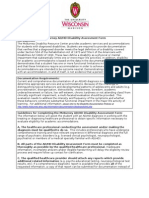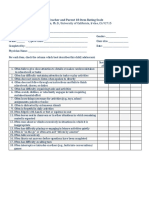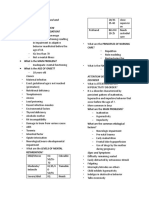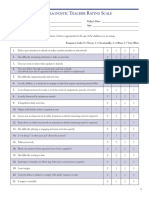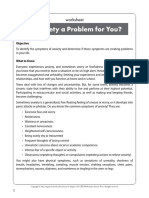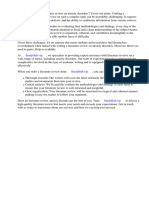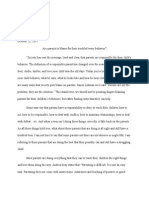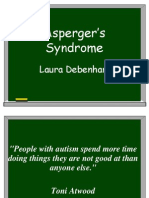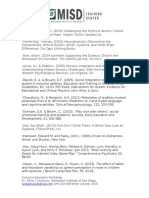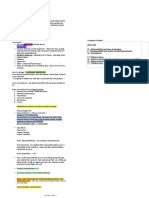Adhd19 Algorithm
Adhd19 Algorithm
Uploaded by
Zayana4Copyright:
Available Formats
Adhd19 Algorithm
Adhd19 Algorithm
Uploaded by
Zayana4Original Title
Copyright
Available Formats
Share this document
Did you find this document useful?
Is this content inappropriate?
Copyright:
Available Formats
Adhd19 Algorithm
Adhd19 Algorithm
Uploaded by
Zayana4Copyright:
Available Formats
Adult ADHD Assessment and Diagnosis Approach
It is suggested that the diagnosis of adult ADHD requires 2-3 visits.
Assessment of ADHD is not a clinical emergency and requires enough time
to gather necessary evidence for the diagnosis.
Suspect ADHD
Self-referral
Adult patient referred for assessment of potential ADHD
Re-assessment of adult patient previously diagnosed with ADHD in childhood
First Visit
• Standard mental health assessment
• Review current symptoms*
• Assess current symptom using a brief validated tool*
• Assess functional impairment at home, work, school and in relation-
ships*
• Identify comorbidities*
• Perform screening for substance use*
• Exclude other disorders
• Assess physical health Consider Referral*: Consider referral to a psychiatrist
• Gather/review additional information in the following several presentations and co-
• Request past medical records and complete medical history
conditions:
• Request childhood and developmental history*
• Identify informants and obtain consent to contact them to collect • Extreme or severe dysfunction
information*
• Schedule a second visit, preferably include an informant who can • Suicidal or homicidal ideations
corroborate symptoms • Substance use or dependence
• Psychosis
• Extreme psychosocial stressors or present trau-
matic events
Second Visit (in 2-4 weeks) • Previous treatment failures
• Review gathered information and assessment results
• Atypical presentation – if presentation as brand
new symptoms this is not ADHD, even if not diag-
• Interview for corroboration of childhood symptoms nosed as a child the symptoms must concur
• Interview for corroboration of current symptoms and disfunction
• Consider severity of impairment
• Meets DSM-5 criteria for ADHD diagnosis*
• Confirm and document diagnosis
Third Visit
• Explain diagnosis*
• Discuss treatment options, risks and benefits*; shared decision-making
• Consider non-pharmacological management*
• Initiate treatment if recommended*
• Discuss need for treatment monitoring
• Educate patient on their responsibilities in managing their condition
and self-management strategies
Follow-up Visits
• New diagnosis, uncontrolled symptoms or change in medication – within 30 days; monthly until functionality is significantly improved;
every 3-6 months once stabilized
• Review symptoms and functional abilities, including diurnal variations in symptoms
• Review impressions of informants
• Monitor for drug adverse effects*
• Monitor for adherence to therapy
• Monitor vital signs (weight, blood pressure and heart rate)
• Monitor for signs of misuse/abuse/diversion
• Adjust therapy as needed
• Assist with additional management strategies for psychological, behavioral, occupation and educational needs (e.g., skill-building
trainings, psycho-education, parenting, vocational and/or educational accommodation)*
* = Resource available in this Toolkit; this approach is suggested as a general guidance only and is modifiable to fit local context;
second and third visits can be combined if enough evidence to diagnose ADHD and initiate treatment
Copyright © 2019 American Academy of Family Physicians. All rights reserved
Authors: Loskutova N, Callen E, Lutgen C; 2019, AAFP National Research Network
Updated August 30, 2019
You might also like
- Ashley Stanford - Asperger Syndrome and Long-Term RelationshipsDocument287 pagesAshley Stanford - Asperger Syndrome and Long-Term Relationshipsjart100% (3)
- LSP 16Document3 pagesLSP 16Ching OBNo ratings yet
- Research Proposal On Depression Among TeenagersDocument7 pagesResearch Proposal On Depression Among TeenagersJeffren P. Miguel84% (38)
- Example Assessment Documentation - Summary ReportDocument2 pagesExample Assessment Documentation - Summary ReportLeanneRaffaele GNo ratings yet
- Directions In: PsychiatryDocument44 pagesDirections In: Psychiatrybrad_99100% (2)
- Psychiatry Lecturio Summary2Document39 pagesPsychiatry Lecturio Summary2Raymond Lorenzo N. RacelaNo ratings yet
- CEFI ScalesDocument3 pagesCEFI ScalesKelly AdamchickNo ratings yet
- Altman Self Rating ScaleDocument2 pagesAltman Self Rating ScaleRifkiNo ratings yet
- Challenging Behaviours (Power Point)Document17 pagesChallenging Behaviours (Power Point)tamNo ratings yet
- Developmental History FormDocument2 pagesDevelopmental History FormocramusNo ratings yet
- Child and Adolescent Developmental History Form # 6180Document6 pagesChild and Adolescent Developmental History Form # 6180ChrisNo ratings yet
- John Smith: PECS Example Comprehensive ADHD ReportDocument33 pagesJohn Smith: PECS Example Comprehensive ADHD Reportgenerjustn100% (2)
- Comprehensive Clinical Assessment & Intake - Adult: Current Treatment FocusDocument7 pagesComprehensive Clinical Assessment & Intake - Adult: Current Treatment FocusAimen MurtazaNo ratings yet
- The Addicted Child: A Parent's Guide to Adolescent Substance AbuseFrom EverandThe Addicted Child: A Parent's Guide to Adolescent Substance AbuseNo ratings yet
- Handbook of Evidence-Based Practice in Clinical Psychology, Child and Adolescent DisordersFrom EverandHandbook of Evidence-Based Practice in Clinical Psychology, Child and Adolescent DisordersNo ratings yet
- Adhd Disability Assessment Form LetterheadDocument7 pagesAdhd Disability Assessment Form LetterheadNavroop Kaur100% (1)
- Psychological Diagnostic QuestionnaireDocument2 pagesPsychological Diagnostic QuestionnaireHira WarsiNo ratings yet
- ADHD Prescribing Algorithm CYPSDocument2 pagesADHD Prescribing Algorithm CYPSGemma GarciaNo ratings yet
- PSYCHIATRIC DISORDERS OF CHILDHOOD (Autosaved)Document43 pagesPSYCHIATRIC DISORDERS OF CHILDHOOD (Autosaved)Amy Lalringhluani Chhakchhuak100% (1)
- Symptoms: Following SignsDocument3 pagesSymptoms: Following SignsAhmed FaidNo ratings yet
- ADHD Report TemplateDocument3 pagesADHD Report TemplateScribdTranslationsNo ratings yet
- Section 504 Examples of Disabilities and AccommodationsDocument17 pagesSection 504 Examples of Disabilities and Accommodationsapi-434662376No ratings yet
- ADHD Screening in AdultsDocument3 pagesADHD Screening in AdultsPanduRespatiNo ratings yet
- Approach To Diagnosis ADHDDocument5 pagesApproach To Diagnosis ADHDAdinda Ratna Puspita100% (1)
- Disorders in Childhood and AdolescenceDocument6 pagesDisorders in Childhood and AdolescenceCamille Joy BaliliNo ratings yet
- Minimum Lab Monitoring Psychotropic MedicationsDocument1 pageMinimum Lab Monitoring Psychotropic MedicationsEllie MehrNo ratings yet
- Differential Diagnosis of 2018Document8 pagesDifferential Diagnosis of 2018Dhino Armand Quispe SánchezNo ratings yet
- Family Based Treatment For Eating DisorderDocument2 pagesFamily Based Treatment For Eating DisorderHana Chan100% (1)
- Release of InformationDocument1 pageRelease of Informationnorniellar100% (1)
- Child Psychiatry - Assessment and TestingDocument24 pagesChild Psychiatry - Assessment and TestingAna Maria PaunNo ratings yet
- ODD Quick Fact Sheet For Parents Guardians and Child Serving Professionals 2.24.14Document2 pagesODD Quick Fact Sheet For Parents Guardians and Child Serving Professionals 2.24.14narcis2009No ratings yet
- Academic Problems Parent Student FormDocument3 pagesAcademic Problems Parent Student FormArnavNo ratings yet
- 3 Types of ADHD - Neurochemical MechanismsDocument2 pages3 Types of ADHD - Neurochemical MechanismsBrendha M100% (1)
- Adjustment DisorderDocument4 pagesAdjustment DisorderRosalba GiovannelliNo ratings yet
- Malingering NbiDocument5 pagesMalingering NbiPridina SyadirahNo ratings yet
- Neuropsychological Assessment in Autism Spectrum Disorder and Related ConditionsDocument9 pagesNeuropsychological Assessment in Autism Spectrum Disorder and Related Conditionsvirginia vianaNo ratings yet
- ADHD ChecklistDocument1 pageADHD Checklistbob cretNo ratings yet
- Types of Learning Disorders and Their SignsDocument11 pagesTypes of Learning Disorders and Their SignsHarisAshfaqHashmiNo ratings yet
- Checklist For Central Auditory Processing Disorder (CAPD)Document1 pageChecklist For Central Auditory Processing Disorder (CAPD)jaywhyeyeNo ratings yet
- PSYCH - MBBS - (Use Outline To Create Other Templates) Anggelos NotesDocument26 pagesPSYCH - MBBS - (Use Outline To Create Other Templates) Anggelos NotesNariska Cooper100% (2)
- Feature SOF Adhd: Module Output No. 1Document5 pagesFeature SOF Adhd: Module Output No. 1Jin VelasquezNo ratings yet
- Adhd Referral CriteriaDocument2 pagesAdhd Referral CriteriaPutryy FitrilyaaNo ratings yet
- John Smith: PECS Example Comprehensive ADHD ReportDocument28 pagesJohn Smith: PECS Example Comprehensive ADHD ReportHala HamdyNo ratings yet
- V Adhd D T R S: Anderbilt Iagnostic Eacher Ating CaleDocument2 pagesV Adhd D T R S: Anderbilt Iagnostic Eacher Ating CaletraviscNo ratings yet
- APA - DSM5 - Level 2 Inattention Parent of Child Age 6 To 17 PDFDocument3 pagesAPA - DSM5 - Level 2 Inattention Parent of Child Age 6 To 17 PDFLiana Storm0% (1)
- Attention-Deficit Hyperactivity DisorderDocument9 pagesAttention-Deficit Hyperactivity Disorderapi-608455943No ratings yet
- Enviando Por Email Teva - ADHD - Guide - 2018 - CCCEP - ENGDocument33 pagesEnviando Por Email Teva - ADHD - Guide - 2018 - CCCEP - ENGLidio NetoNo ratings yet
- Mental Health Plan Assessment Form: Relationship PhoneDocument6 pagesMental Health Plan Assessment Form: Relationship Phonealotfya100% (1)
- Adhd Psych AssessmentDocument13 pagesAdhd Psych AssessmentJoan G. Huyo-aNo ratings yet
- ASRS-ADHD-self-report-scale-2 2Document2 pagesASRS-ADHD-self-report-scale-2 2Alexys Archie100% (1)
- A Pa Suicide Guidelines Review ArticleDocument8 pagesA Pa Suicide Guidelines Review Articlenikko268No ratings yet
- Diagnosis of AdhdDocument41 pagesDiagnosis of AdhdJohny JosephNo ratings yet
- Adhd - Asrs .ScreenDocument4 pagesAdhd - Asrs .ScreenKenth GenobisNo ratings yet
- Pediatric and Adolescent Mental HealthDocument33 pagesPediatric and Adolescent Mental HealthHervis FantiniNo ratings yet
- University of Bristol - Explore Bristol ResearchDocument10 pagesUniversity of Bristol - Explore Bristol ResearchPaula MacielNo ratings yet
- Assessment Tests and ToolsDocument18 pagesAssessment Tests and ToolsArshia AzizNo ratings yet
- Sexual Health Inventory For Men (Shim) : Patient Name: Today'S Date: Patient InstructionsDocument1 pageSexual Health Inventory For Men (Shim) : Patient Name: Today'S Date: Patient InstructionsMarilena JuncuNo ratings yet
- Psychiatric Interview Module 1Document41 pagesPsychiatric Interview Module 1Spj Bernardo100% (1)
- APA - DSM 5 Depression Bereavement Exclusion PDFDocument2 pagesAPA - DSM 5 Depression Bereavement Exclusion PDFDaniel NgNo ratings yet
- AIMS. Scales-Abnormal-Involuntary-Movement-Scale PDFDocument2 pagesAIMS. Scales-Abnormal-Involuntary-Movement-Scale PDFVictoria RomeroNo ratings yet
- Mental Health Medications For Children - Fact Sheets - Yale MedicineDocument5 pagesMental Health Medications For Children - Fact Sheets - Yale MedicinewaleskacrzNo ratings yet
- WorksheetsDocument181 pagesWorksheetscatamedellin2011No ratings yet
- Symptom Overreporting and Dissociative Experiences: A Qualitative ReviewDocument13 pagesSymptom Overreporting and Dissociative Experiences: A Qualitative ReviewKamiNo ratings yet
- Fragile X Syndrome and Premutation Disorders: New Developments and TreatmentsFrom EverandFragile X Syndrome and Premutation Disorders: New Developments and TreatmentsRandi J HagermanNo ratings yet
- Running Head: Psychological Effects of PovertyDocument6 pagesRunning Head: Psychological Effects of PovertyKevin Nyasongo NamandaNo ratings yet
- Gambling Addiction Rehab CentersDocument2 pagesGambling Addiction Rehab Centerskim_dy28No ratings yet
- NP5Document7 pagesNP5Kevin VillaranteNo ratings yet
- Child Psychopathology TreatmentDocument458 pagesChild Psychopathology TreatmentvictorpsycheNo ratings yet
- (Lecture 6) Vice, Drug Education and ControlDocument10 pages(Lecture 6) Vice, Drug Education and ControlJohnpatrick DejesusNo ratings yet
- Hamilton D ScoringDocument1 pageHamilton D ScoringJoezerk Jhon BielNo ratings yet
- How To Stop RuminatingDocument5 pagesHow To Stop RuminatingJunNo ratings yet
- EbdDocument1 pageEbdapi-352507025No ratings yet
- Literature Review Anxiety DisorderDocument5 pagesLiterature Review Anxiety Disordervrxhvexgf100% (1)
- Position PaperDocument5 pagesPosition Paperapi-302422100100% (3)
- Human Behaviour and VictimologyDocument59 pagesHuman Behaviour and VictimologyyokaikervinNo ratings yet
- Posttraumatic Cognitions Inventory (PTCI)Document2 pagesPosttraumatic Cognitions Inventory (PTCI)Jessica KruminsNo ratings yet
- Rupal Arora - ASDDocument23 pagesRupal Arora - ASDrupal aroraNo ratings yet
- Panic, Assessment PDSS, ScoringDocument1 pagePanic, Assessment PDSS, ScoringTeodora TudorNo ratings yet
- I Am Sharing - Konseling UBM 2020 - With YouDocument57 pagesI Am Sharing - Konseling UBM 2020 - With YoupasebatNo ratings yet
- Asperger's Syndrome: Laura DebenhamDocument22 pagesAsperger's Syndrome: Laura Debenhampopotitos52No ratings yet
- BpadDocument27 pagesBpadnikitabhattarai20No ratings yet
- Pleasurable Activity JournalDocument2 pagesPleasurable Activity JournalEa AndreNo ratings yet
- VoyeurismDocument10 pagesVoyeurismMilton ThiraviyamNo ratings yet
- Hallowell, Edward M. and Ratey, John J. (1994) Driven To DistractionDocument3 pagesHallowell, Edward M. and Ratey, John J. (1994) Driven To DistractionWilman OngNo ratings yet
- Muet Speaking TestDocument2 pagesMuet Speaking TestMUHAMMAD AKBAR KUGHAN BIN MUHAMMAD DANIAL PHILIP MoeNo ratings yet
- Psychiatry ManiaDocument2 pagesPsychiatry ManiaDevangkumar PatelNo ratings yet
- Asperger's Syndrome: A Case: GoodmanDocument2 pagesAsperger's Syndrome: A Case: GoodmanveraciobanuNo ratings yet
- Official Handout For Somatoform DisordersDocument17 pagesOfficial Handout For Somatoform DisorderskeziahNo ratings yet
- Cel2103 Writing Portfolio Task 4Document8 pagesCel2103 Writing Portfolio Task 4Muhammad Raimi AyobNo ratings yet
- Signs and SymptomsDocument10 pagesSigns and SymptomsSandyNo ratings yet















